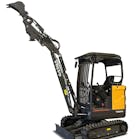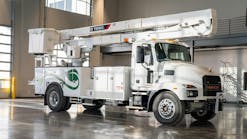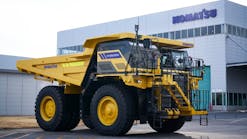Fuel efficiency is a measure of how much work a machine can do with one gallon of fuel—that is, the amount of material it can move, whether measured in cubic yards or tons, with that volume of fuel.
Some would say that fuel efficiency is a prime indicator of overall design refinement when comparing the merits of two machines, because the machine with the better number typically has significant design improvements in areas that contribute to higher productivity (more powerful hydraulics, more efficient digging mechanism, more robust structures—for instance), as well as significant design improvement in areas that contribute to lower fuel consumption, whether the engine itself, load-sensing hydraulics, on-demand cooling fans, or more efficient ground-engaging tools.
Read also: Strategies to better manage diesel fuel costs
Given today’s high fuel prices, machine owners increasingly are taking note of how much fuel a particular machine is using, compared with that of a similar machine.
Even though the fuel-efficiency number is the truest indicator of how well a machine uses a gallon of fuel, most machine owners simply don’t have the time or resources to determine the comparative fuel efficiency of machines in their fleets, which would entail detailed production studies in conjunction with careful measurement of fuel consumption. Frequently then, the basis for comparison becomes simply a measure of how much fuel one machine consumes in an hour, versus the consumption of another machine. This basic measurement is known as the “fuel burn rate.”
Those in the industry who think about such things, however, urge caution when using the fuel burn rate as a basis for comparison; unless you know what elements constitute the burn rate, they say, and how those elements can be influenced, you could draw false conclusions.
Caterpillar recently published an informative discussion about this very subject in the promotional literature for the new K-Series medium wheel loaders, “Understanding Fuel Efficiency and Fuel Burn Rate.” The company makes the point that the fuel burn rate (again, simply gallons burned per hour) is influenced by “four major factors.”
Factors affecting burn rate
- Machine Application: The type of work the machine performs is a primary factor. In a difficult load-and-carry application (in a sand-and-gravel pit, for instance), says Caterpillar, a loader might burn 60 to 100 percent more fuel than the same machine in a truck-loading application in an aggregates yard.
- Operator Technique: Operator technique has a tremendous affect on the fuel burn rate. For example, an operator maintaining an aggressive truck-loading cycle of 20 seconds or less, says Caterpillar, can cause the machine to burn 60 to 80 percent more fuel than the same machine working at a more moderate pace, say, 30 seconds per cycle.
Operator technique also extends to the manner of shifting the machine. Many wheel loaders have an auto-shift mode for the transmission, and fuel consumption usually can be reduced, says Caterpillar, if the operator uses the automatic system, versus shifting manually. Operators shifting manually tend to wait too long before changing gears, allowing engine speed to increase. A basic tenet of fuel consumption, says Caterpillar, is that fuel burn is directly proportional to engine speed.
In comparative tests that Caterpillar conducted between identical K-Series loaders—one shifted automatically, the other shifted manually—the fuel burn rate for the automatically shifted machine was some 15 percent less. Automatic shift systems in wheel loaders have generally become quite refined; the K-Series, for instance, uses a new shift strategy that electronically considers both ground speed and torque requirements when selecting the gear for a particular operating situation. - Idle Time: The percentage of time a machine idles has a significant influence on the fuel burn rate. A medium wheel loader, says Caterpillar, typically consumes less than a gallon per hour when idling. On the other hand, a 369-horsepower 980K working steadily (no idle time) in a difficult application (such as the load-and-carry cited earlier) might burn more than 12 gallons per hour. Yet, most 980K owners, if asked, would probably say that their machine typically burns five to six gallons per hour.
Here’s the point to remember, says Caterpillar: The higher the percentage of idle time, the lower the overall fuel burn. The company’s research, in fact, indicates that idle time of 30 to 40 percent is common for machines in North America. So, if you think that a machine in your fleet having a burn rate of six gallons per hour on the monthly fuel report is using fuel twice as efficiently as a similar machine that burns 12 gallons per hour, think again—and take a look at the idle-time column. - Machine Configuration: The particular features a machine incorporates also can influence the fuel burn rate, Caterpillar reminds us. The company’s literature that we’ve been citing enumerates some of those features that potentially can diminish the fuel burn rate: Tier 4 Interim engines; electronic fuel systems; on-demand, hydraulically driven cooling fans; engine-idle-management/shutdown systems; load-sensing hydraulics; lock-up-clutch torque converter; and buckets that load easier than others. The more such features built into a machine, the greater its inherent ability to reduce fuel burn.
So, if you’re making equipment-management decisions based on the fuel burn rate of various machines, first make sure you’re comparing apples to apples. Enhanced machine technology has made important contributions to fuel efficiency, but according to Caterpillar, the really big gains are in understanding application differences, improving operator technique, and controlling idle time.





